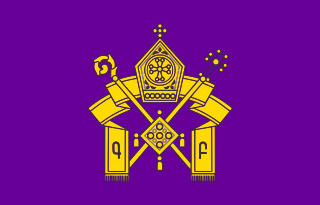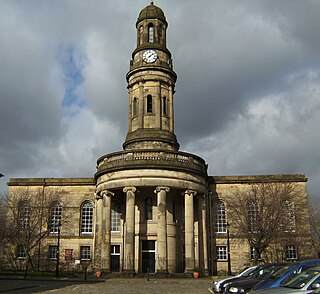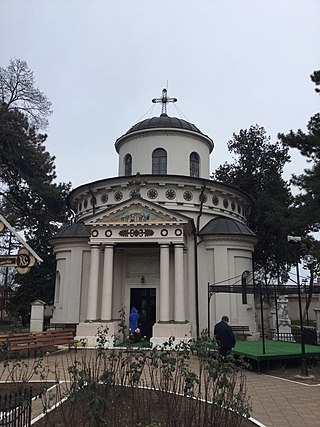
Gregory the Illuminator was the founder and first official head of the Armenian Apostolic Church. He converted Armenia from Zoroastrianism to Christianity in the early fourth century, making Armenia the first state to adopt Christianity as its official religion. He is venerated as a saint in the Armenian Apostolic Church and in some other churches.

Etchmiadzin Cathedral is the mother church of the Armenian Apostolic Church, located in the city dually known as Etchmiadzin (Ejmiatsin) and Vagharshapat, Armenia. It is usually considered the first cathedral built in ancient Armenia, and often regarded the oldest cathedral in the world.

The Tuscan order is one of the two classical orders developed by the Etruscans, the other being the composite order. It is influenced by the Doric order, but with un-fluted columns and a simpler entablature with no triglyphs or guttae. While relatively simple columns with round capitals had been part of the vernacular architecture of Italy and much of Europe since at least Etruscan architecture, the Romans did not consider this style to be a distinct architectural order. Its classification as a separate formal order is first mentioned in Isidore of Seville's Etymologies and refined during the Italian Renaissance.
The Cathedral of the Good Shepherd is the oldest Catholic church in Singapore, built in 1847. It is located in the Museum Planning Area within the Civic District.

Holy Trinity Church is in Church Road, Wavertree, Liverpool, Merseyside, England. It is an active Anglican parish church in the diocese of Liverpool, the archdeaconry of Liverpool, and the deanery of Toxteth and Wavertree. The church is recorded in the National Heritage List for England as a designated Grade II* listed building. It was described by John Betjeman as "Liverpool's best Georgian church".

Germigny-des-Prés is a commune in the Loiret department in north-central France.

Saint Hripsime Church is a seventh century Armenian Apostolic church in the city of Vagharshapat (Etchmiadzin), Armenia. It is one of the oldest surviving churches in the country. The church was erected by Catholicos Komitas to replace the original mausoleum built by Catholicos Sahak the Great in 395 AD that contained the remains of the martyred Saint Hripsime to whom the church is dedicated. The current structure was completed in 618 AD. It is known for its fine Armenian-style architecture of the classical period, which has influenced many other Armenian churches since. It was listed as a UNESCO World Heritage Site along with other nearby churches, including Etchmiadzin Cathedral, Armenia's mother church, in 2000.

Saint Gregory the Illuminator Church, commonly referred to as the Armenian Church of Baku, is a former Armenian Apostolic church near Fountains Square in central Baku, Azerbaijan. Completed in 1869, it was one of the two Armenian churches in Baku to survive the Soviet anti-religious campaign and the Nagorno-Karabakh conflict and the 1990 pogrom and exodus of Baku Armenians when it was looted. It is now the only standing Armenian monument in Baku.

Armenian architecture comprises architectural works with an aesthetic or historical connection to the Armenian people. It is difficult to situate this architectural style within precise geographical or chronological limits, but many of its monuments were created in the regions of historical Armenia, the Armenian Highlands. The greatest achievement of Armenian architecture is generally agreed to be its medieval churches and seventh century churches, though there are different opinions precisely in which respects.

Baghdasar Arzoumanian was an Armenian architect and designer based in Yerevan, Armenia. He designed a large body of civil and religious buildings as well as many smaller works.

Zvartnots Cathedral is a medieval Armenian cathedral near Vagharshapat (Ejmiatsin), Armenia. Built in the seventh century and now lying in ruins, Zvartnots was noted for its circular exterior structure, unique in medieval Armenian architecture, and a set of interior piers that upheld a multifloor structure crowned with a dome.

Vagharshapat is the 4th-largest city in Armenia and the most populous municipal community of Armavir Province, located about 18 km (11 mi) west of the capital Yerevan, and 10 km (6 mi) north of the closed Turkish-Armenian border. It is commonly known as Ejmiatsin, which was its official name between 1945 and 1995. It is still commonly used colloquially and in official bureaucracy, a case of dual naming.

The Church of Shoghakat was erected in 1694 by Prince Aghamal Sorotetsi during the reign of Catholicos Nahabed I in the city of Vagharshapat (Etchmiadzin), in Armenia's Armavir Province.

The Saint Gregory the Illuminator Cathedral, also known as the Yerevan Cathedral is the largest cathedral of the Armenian Apostolic Church. It is located in the Kentron District of Yerevan, the capital of Armenia, and is one of the largest religious buildings in the South Caucasus along with the Holy Trinity Cathedral of Tbilisi. Adjacent to the General Andranik metro station, it is visible from many areas of Yerevan.

St John the Evangelist's Church is a redundant Anglican church in North Road, Lancaster, Lancashire, England. It is recorded in the National Heritage List for England as a designated Grade II* listed building, and is under the care of the Churches Conservation Trust.

Mother See of Holy Etchmiadzin, known in Armenian as simply the Mother See, is the governing body of the Armenian Apostolic Church. It is headquartered around Etchmiadzin Cathedral in Vagharshapat (Etchmiadzin), Armenia and is the seat of the Catholicos of All Armenians, the head of the church.

St Philip's Church is an Anglican parish church in the diocese of Manchester, in the deanery and archdeaconry of Salford. The church was renamed in 2016 as Saint Philip's Chapel Street. It is located at Wilton Place, off Chapel Street in Salford, Greater Manchester, England.

St James' Church is in High Street, Whitehaven, Cumbria, England, at the crossing with the top of Queen Street. It stands in an elevated position overlooking the town. The church is an active Anglican parish church in the deanery of Calder, the archdeaconry of West Cumberland, and the diocese of Carlisle. The church is recorded in the National Heritage List for England as a designated Grade I listed building.

The Saint Gregory the Illuminator Church of Galata is the oldest extant Armenian Apostolic church in Istanbul. It was built in the late 14th century, in the Genoan period, shortly before the fall of Constantinople to the Ottomans. Located in Galata (Karaköy), it is the city's only church built in the traditional style of the Armenian church architecture—namely with a dome with a conical roof.

The Teiul Doamnei Ghica Church is a Romanian Orthodox church located at 3 Doamna Ghica Street in Bucharest, Romania. It is dedicated to the Feast of the Ascension.
































